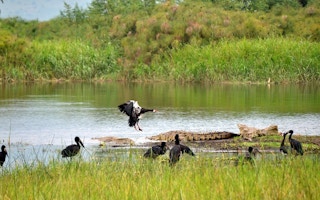As far as conservation strategies go, payments for ecosystem services (PES) are based on a relatively simple concept — perhaps deceptively simple.
The idea behind PES is, essentially, to pay landowners to protect their land in the interest of ensuring the provision of some “service” rendered by nature, such as clean water, habitat for wildlife, or carbon storage in forests.
One of the most attractive aspects of PES programs is that they don’t just channel investments into environmental conservation. People also reap the rewards of those investments, literally and figuratively.
That means that PES, in theory, can help alleviate poverty and reduce the conflicts that can arise between conservationists and local communities at the same time that it ties conservation funds directly to activities that benefit the planet.
The devil, of course, is in the details. PES programs are typically voluntary, meaning landowners must choose to participate by enrolling their land. But if they choose to participate, that might be because there is no other use for their land for which they could be better compensated, meaning the land might not have been at risk to begin with.
On the other hand, if the landowner has a genuine interest in keeping their patch of forest standing, how can you be sure that they wouldn’t have protected that forest even without getting paid?
“
You need to have payments horizons that are large enough, because typically, depending on the environmental setting, the problem is not likely to go away just by paying for a couple years.
Sven Wunder, senior economist, Center for International Forestry Research
Paul Ferraro, a professor at Johns Hopkins University whose research focuses on the design and evaluation of environmental programs, told Mongabay that protected areas are not simple to evaluate either, but they’re more straightforward than PES.
The areas are generally selected for conservation by a government, and it is possible to have some understanding of what affects that government’s choice. It is therefore easier to control for the factors that affect that choice when designing research into how effective a protected area is at conserving the land.
“But in PES, there’s administrative selection and then there’s the landowner’s or the land user’s choice to participate or not,” Ferraro told Mongabay, “and it’s a lot harder to disentangle the characteristics of the people who participate in PES and the actual effect of the PES program.”
For that matter, how do you even decide which regions to make PES programs available in?
You’d obviously want to implement your conservation program in the most threatened landscapes — there’s no sense in spending limited conservation funds to protect a forest that’s not at risk of being cut down in the first place. But predicting where deforestation is most likely to occur is a trick in itself.
“Let’s say in the Amazon you have had deforestation rates of 0.5 percent per year, something like that. But that actually means that if you had, hypothetically, say 1,000 forest plots, only five of those would disappear every year.
So it becomes very important to protect the right ones, and to kind of guess what the right ones are,” Sven Wunder, a senior economist at the Center for International Forestry Research (CIFOR), told Mongabay.
Once a site is selected for PES implementation, how do you guarantee that the deforestation the program deters won’t simply pop up in a nearby unprotected forest instead? How do you make sure any of a number of other factors wouldn’t have lowered the deforestation rate whether or not a PES program was implemented?
Or say an agricultural company wants to turn the forest into a highly profitable oil palm or soy plantation and is willing to compensate the owner of the land handsomely. How do you raise the money to make payments big enough to convince the landowner to join the PES program instead?
And how do you ensure that those funds remain available in perpetuity? “You need to have payments horizons that are large enough, because typically, depending on the environmental setting, the problem is not likely to go away just by paying for a couple years,” Wunder said.
What’s more, how do you decide how much to pay each landowner enrolled in the PES program? Do you pay them all equally, or do you weight the payments based on the degree of threat to their land? (A higher threat level often means that the land is also more valuable.)
And what do you make those payments contingent upon — the number of trees still standing? The quality of the water at the lower end of the watershed? The population numbers of wildlife harbored on the land? Whatever you choose to tie the payments to, where does the money come from to monitor the effects of the program, and who performs this verification?
Socio-economic outcomes are key
PES is a relatively new conservation strategy, an offshoot of various other mechanisms developed in the past, particularly one called Integrated Conservation and Development Programs (ICDPs). These were also known as “eco-development” or “grassroots conservation” because of their focus on economic development and the needs of local people and communities as much as on environmental conservation.
PES is essentially an upgraded, more direct version of ICDPs, which is a big part of the reason why it places a strong emphasis on delivering a variety of socio-economic outcomes, especially reduction of inequality and marginalization of the poor and other disadvantaged groups, like households headed by women.
It’s worth noting that some people are fundamentally against PES, or any market-based conservation mechanism, because they object to the idea of putting a monetary value on nature.
These opponents of PES also sometimes argue that paying people to conserve will just discourage them from protecting nature as soon as the payments stop.
This story was published with permission from Mongabay.com. Read the full story.










